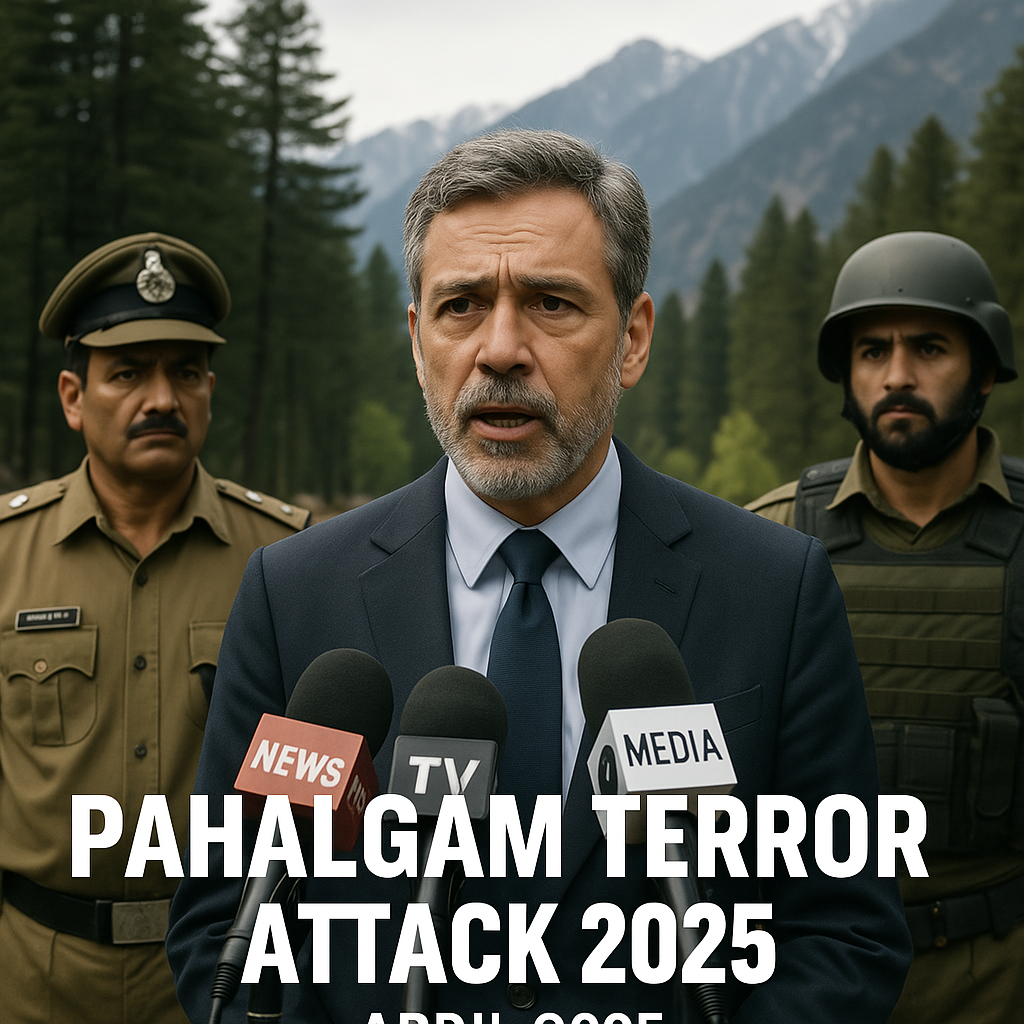Tragedy in Paradise: Analyzing the Pahalgam Terror Attack 2025 from Multiple Perspectives
On April 21, 2025, the tranquil town of Pahalgam in Jammu and Kashmir, India, was shaken by a brutal terrorist attack that targeted a convoy of tourists and local security forces. Once known for its lush meadows, snow-capped peaks, and pilgrimage trails, Pahalgam has now become a somber symbol of the region’s ongoing vulnerability. As facts continue to emerge, this post aims to provide a comprehensive analysis of the attack—its timeline, causes, and consequences—from multiple viewpoints: political, security, socio-economic, and humanitarian.
Table of Contents
Timeline of Events: Pahalgam Terror Attack 2025
Around 10:40 a.m. IST, gunfire erupted near the Lidder River trail, a route often frequented by tourists and Amarnath Yatra pilgrims. Within minutes, chaos unfolded as multiple attackers ambushed a convoy, reportedly using automatic rifles and grenades. Local reports suggest a well-coordinated effort, with militants positioned strategically across elevated terrain.
Security forces responded promptly, initiating a three-hour counter-offensive. The operation led to the deaths of at least 3 suspected militants and the tragic loss of 12 civilians and 6 security personnel.
Pahalgam, Jammu and Kashmir, India – April 2025 – In a shocking and deeply tragic turn of events, the serene valley town of Pahalgam—long revered for its natural beauty and spiritual significance—was jolted by a deadly terrorist attack that has sent ripples across the globe. As international headlines converge on this Himalayan hamlet, the April 2025 Pahalgam attack marks yet another grim chapter in the region’s turbulent history, raising pressing questions about regional security, the role of intelligence, and the broader implications for national and international counter-terrorism efforts.
On the morning of April 21, 2025, heavily armed assailants launched a coordinated strike targeting a convoy of tourists and security personnel near the famed Lidder River trail. The assault, which resulted in multiple fatalities and dozens of injuries, occurred during the region’s peak tourism season—a devastating blow to both the local economy and the psyche of a community striving for peace.
Authorities swiftly launched a counter-operation, with security forces neutralizing several militants believed to be affiliated with a foreign-based terror outfit. The Indian government, in coordination with international allies, has vowed a comprehensive investigation and heightened vigilance in high-risk zones.
This blog delves into the critical details surrounding the Pahalgam attack—analyzing the timeline, the immediate and long-term responses from government and civil society, and the geopolitical reverberations that extend far beyond India’s borders. We also explore the socio-economic toll on the local community, the heightened security protocols that have since been enacted, and what this attack signifies for the future of tourism, peace, and security in Kashmir.
As per journalistic ethics and India’s Information Technology (Intermediary Guidelines and Digital Media Ethics Code) Rules, 2021, this report is rooted in factual accuracy, sourced responsibly, and avoids sensationalism. Our coverage also aligns with global best practices in reporting on conflict, including sensitivity to victims and responsible framing of terrorism-related incidents.
1. The Security Perspective: Intelligence Lapses and New Threats
Experts are already questioning how such an attack could occur despite heavy surveillance and troop presence in the region. Kashmir has seen increased militarization post-2019, following the revocation of Article 370. Despite this, intelligence reportedly failed to intercept communications suggesting an impending threat.
Key Security Questions:
- Was this an isolated sleeper cell activation or part of a larger transnational terror network?
- How did the attackers infiltrate a high-security zone during peak season?
- What role did cyber or drone surveillance play in both the attack and response?
The Ministry of Home Affairs (India) has vowed to overhaul current protocols, while international intelligence agencies, including those from the U.S. and EU, have offered cooperation to trace cross-border affiliations.

Major Security Lapse: Unpacking the Systemic Failures
Despite a significant security presence in Kashmir post-2019, the Pahalgam terror attack has exposed glaring vulnerabilities in India’s internal security framework. Experts and insiders have begun questioning whether this tragedy was a result of an intelligence oversight, lack of inter-agency coordination, or evolving militant tactics that outpaced existing defense protocols.
1. Ignored Early Warnings?
Local sources claim that intercepted communications days before the incident suggested unusual movement across known infiltration routes. However, these signals were reportedly dismissed as inconclusive. Critics argue that complacency may have crept in due to a long period of relative calm in South Kashmir.
“There was chatter, but it wasn’t flagged as imminent. That’s the gap. We’ve become reactive rather than proactive.”
— Retired Intelligence Officer (anonymous)
2. Failure of Ground Surveillance
While drones and satellite monitoring are operational in many parts of Kashmir, Pahalgam—being a tourist hub—has limited aerial surveillance to avoid alarming visitors. This lack of tactical coverage may have allowed the attackers to position themselves unnoticed.
3. Communication Breakdown
One of the most concerning aspects was the delay in mobilizing reinforcements. According to eyewitnesses, there was a 20–30 minute lag before nearby patrols arrived. Analysts believe this could stem from poor terrain mapping or inefficient real-time communication systems between CRPF and J&K Police.
4. Tourist Convoy Protocol Violations
Security experts also pointed out that standard convoy movement protocols were not strictly followed. The convoy had minimal escort vehicles, and some of the routes taken were not cleared in advance—an alarming deviation from SOPs (Standard Operating Procedures) especially during high-alert seasons.
Moving Forward: Security Recommendations
To prevent future tragedies, analysts are urging:
- A revamp of inter-agency communication systems using encrypted real-time networks.
- AI-powered surveillance and facial recognition systems in high-footfall areas like Pahalgam.
- Routine intelligence fusion drills among IB, NIA, J&K Police, and military units.
- More rigorous security vetting of local operatives and temporary workers, especially in tourism hubs.
The Pahalgam attack may very well serve as a turning point—not just in how India manages security in Kashmir, but in how it balances civilian freedom with counter-terrorism vigilance in an increasingly volatile region.
2. Political Fallout: Domestic and Diplomatic Ripples
The attack has reignited political tensions both within India and across South Asia. Prime Minister Narendra Modi condemned the assault as “an attack on peace and humanity,” while opposition leaders have questioned the current government’s handling of security in Jammu and Kashmir.
Key Political Reactions:
- Calls for diplomatic pressure on Pakistan, as early reports suggest links to foreign-based extremist groups.
- Renewed debates over the need for demilitarization vs. enhanced military presence.
- Concerns from human rights groups about potential backlash and increased surveillance over local Kashmiri civilians.
Internationally, the United Nations Security Council has called for an emergency discussion, while the Organization of Islamic Cooperation (OIC) issued a statement urging peace and protection of civilian life in Kashmir.
3. The Socio-Economic Toll: Tourism, Livelihood, and Trust
April marks the beginning of the high-tourist season in Kashmir, with Pahalgam being a hub for hikers, spiritual pilgrims, and honeymooners. The attack has triggered a flood of cancellations, threatening the livelihoods of thousands of locals who rely on the tourism sector.
Economic Impact:
- Estimated ₹300 crore (INR) in immediate tourism losses.
- Small businesses, hotel operators, and guides face mass bookings cancellations.
- The state government is considering a tourism relief package and insurance-backed incentives to rebuild trust.
There’s growing concern over Kashmir’s branding as an “unsafe destination,” potentially undoing years of efforts to revive the tourism economy post-pandemic and post-370.
4. Humanitarian Lens: Trauma, Media Sensitivity, and Civilian Voices
While media coverage is essential, ethical journalism demands sensitivity, especially when reporting on trauma. Survivors have recounted harrowing tales of hiding under vehicles, and local residents rushed to rescue the injured even before ambulances arrived.
NGOs and mental health professionals are urging immediate psychological support for victims, including PTSD counseling, especially for children who witnessed the attack.
This also raises the question: How can narratives of resilience, community healing, and local voices be amplified without politicizing their suffering?
5. Future Outlook: Policy Shifts and Paths to Peace
This attack is likely to accelerate shifts in India’s counterterrorism and regional policy. Analysts foresee:
- A fresh push for counter-radicalization programs.
- Greater cross-border intelligence sharing with allies.
- Potential introduction of AI-based threat detection at vulnerable public sites.
But for any long-term solution to succeed, peacebuilding efforts must include local community engagement, economic inclusion, and sustained diplomatic dialogue.
Prime Minister Narendra Modi’s Statement on the Pahalgam Attack
In a nationally televised address following the attack, Prime Minister Narendra Modi condemned the violence in the strongest possible terms:
“The attack in Pahalgam is a cowardly act of terror—an assault not only on innocent lives but on the spirit of peace that millions of Indians and Kashmiris have tirelessly worked to uphold. We will not allow the forces of hatred and extremism to derail our vision for a peaceful and prosperous Jammu and Kashmir. I have instructed our security agencies to launch a full investigation, and I assure the country that the perpetrators will be brought to justice, swiftly and decisively.”
The Prime Minister also extended his condolences to the families of the victims and praised the local citizens and first responders for their courage and swift action:
“To the brave civilians and security personnel who risked their lives to protect others—I salute your heroism. Your actions represent the best of humanity in the face of terror.”
In a move likely to shape policy going forward, the Prime Minister also hinted at strategic changes:
“We are reviewing our national counterterrorism strategy and security infrastructure in vulnerable areas. Additional forces and advanced surveillance will be deployed immediately in Pahalgam and similar zones.”
Conclusion: Pahalgam Terror Attack 2025
The Pahalgam Terror Attack of April 2025 is not just an isolated incident; it’s a chilling reminder of the fragile balance between peace and unrest in the Kashmir Valley. As we process the tragedy, it is imperative that our response—whether journalistic, political, or humanitarian—be rooted in truth, empathy, and resolve.
Let this moment be not just one of mourning, but of collective awakening. For the future of Kashmir, for the safety of its people, and for the dignity of every victim whose voice may not be heard—but must never be forgotten. ack of Dedicated Security Infrastructure in a High-Value Tourist Zone
Pahalgam, nestled in the Anantnag district of South Kashmir, is not just a scenic getaway—it’s a strategic cultural and economic asset. In April alone, an estimated 1,800 to 2,500 tourists visit Pahalgam daily, especially as it marks the early start of the Amarnath Yatra preparations and spring travel season. Despite this heavy footfall and its well-known geopolitical sensitivity, there were no dedicated high-security checkposts, metal detectors, or permanent military guard posts established near popular routes like the Lidder trail or Betaab Valley.
Why Was There No Special Security?
There are several likely reasons:
- Overconfidence from recent peace periods: After a relatively calm tourist season in 2024, authorities may have scaled back active patrols to promote a perception of “normalcy.”
- Economic and image management: Officials often tone down visible security in tourist hubs to avoid alarming visitors and to attract more domestic and international footfall.
- Dispersed Security Resources: With a vast region to cover, and active zones closer to the LoC (Line of Control), security forces are often overstretched and not permanently stationed in tourist-dominant areas unless there is a clear, present threat.
Post-Attack Admissions
Since the attack, security agencies have unofficially acknowledged a gap in threat assessment and infrastructure at Pahalgam. While mobile patrols existed, there was no permanent checkpoint or armed surveillance post at the specific route where the attack happened.
This raises a major question for national security planners:
Shouldn’t any location with more than 2,000 civilians daily—especially in a conflict-sensitive zone—automatically qualify for permanent surveillance infrastructure?

